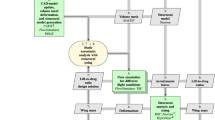Abstract
DLR was involved in the aerodynamic design and evaluation of the innovative high-speed compound helicopter demonstrator RACER, developed under the lead of Airbus Helicopters. This paper presents low-fidelity analyses and optimizations performed to supplement RANS simulations in the design and evaluation process of the RACER wings and tail. A toolchain based on the 3D panel method VSAERO was implemented to quickly perform such tasks. The presented applications include component interaction analyses, optimization of circulation distribution, evaluation of flap efficiency and evaluation of different tail designs. The results helped to gain better understanding of the complex RACER configuration aerodynamics including interaction effects of various components. Moreover, the computational effort could be considerably reduced by the proposed method compared to RANS simulations. Nevertheless, one must be aware of the method restrictions and carefully check whether their application is reasonable for each use case.
Access this chapter
Tax calculation will be finalised at checkout
Purchases are for personal use only
Similar content being viewed by others

References
Airbus Homepage. https://www.airbus.com/newsroom/news/en/2016/06/clean-sky-2.html. Accessed 8 Mar 2018
Wentrup, M., Yin, J., Kunze, P., Streit, T., Wendisch, J.-H., Schwarz, T., Pinacho, J.-P., Kicker, K., Fukari, R.: An overview of DLR compound rotorcraft aerodynamic activities within the CleanSky2 NACOR project. In: AHS International 74th Annual Forum & Technology Display, Phoenix, Arizona, USA (2018)
Gerhold, T.: Overview of the hybrid RANS code TAU. In: Kroll, N., Fassbender, J.K. (eds.) MEGAFLOW - Numerical Flow Simulation for Aircraft Design. Notes on Numerical Fluid Mechanics and Multidisciplinary Design (NNFM), cp, vol. 89, pp. 81–92. Springer, Heidelberg (2005). https://doi.org/10.1007/3-540-32382-1_5
Nathman, J.K.: VSAERO – A Computer Program for Calculating the Nonlinear Aerodynamic Characteristics of Arbitrary Configurations. User’s Manual, Version 7.2., Analytical Methods Inc. (2007)
Drela, M.: XFOIL: an analysis and design system for low Reynolds number airfoils. In: Mueller, T.J. (ed.) Low Reynolds Number Aerodynamics. Lecture Notes in Engineering, vol. 54, pp. 1–12. Springer, Heidelberg (1989). https://doi.org/10.1007/978-3-642-84010-4_1
Brezillon, J., Abu-Zurayk, M.: Aerodynamic inverse design framework using discrete adjoint method. In: New Results in Numerical and Experimental Fluid Mechanics VIII: Contributions to the 17th STAB/DGLR Symposium, Berlin, Germany, 2010, pp. 489–496. Springer, Heidelberg (2013). https://doi.org/10.1007/978-3-642-35680-3_58
Wilke, G.: Variable fidelity optimization of required power of rotor blades: investigation of aerodynamic models and their application. In: 38th European Rotorcraft Forum, Amsterdam, Netherlands (2012)
Rowan, T.: Functional stability analysis of numerical algorithms. Ph.D. thesis, Department of Computer Sciences, University of Texas at Austin (1990)
Demasi, L.: Investigation on the conditions of minimum induced drag of closed wing systems and C-wings. J. Aircr. 44, 81–99 (2007)
Franz, T., Zimmermann, R., Görtz, S., Karcher, N.: Interpolation-based reduced-order modelling for steady transonic flows via manifold learning. Int. J. Comput. Fluid Dyn. 28(3–4), 106–121 (2014). https://doi.org/10.1080/10618562.2014.918695
Franz, T.: Reduced-order modeling for steady transonic flows via manifold learning. Ph.D. thesis, Technische Universität Braunschweig (2015)
Acknowledgments
The authors would like to thank ONERA and Airbus Helicopters for the intense and fruitful cooperation. This project has received funding from the European Union’s Horizon 2020 research and innovation program under grant agreement No. CS2-AlR-GAM-2014-2015-01.
Author information
Authors and Affiliations
Corresponding author
Editor information
Editors and Affiliations
Rights and permissions
Copyright information
© 2020 Springer Nature Switzerland AG
About this paper
Cite this paper
Kunze, P., Wentrup, M. (2020). Aerodynamic Analysis and Optimization of Wings and Tail Surfaces of a Compound Helicopter with Box Wing. In: Dillmann, A., Heller, G., Krämer, E., Wagner, C., Tropea, C., Jakirlić, S. (eds) New Results in Numerical and Experimental Fluid Mechanics XII. DGLR 2018. Notes on Numerical Fluid Mechanics and Multidisciplinary Design, vol 142. Springer, Cham. https://doi.org/10.1007/978-3-030-25253-3_36
Download citation
DOI: https://doi.org/10.1007/978-3-030-25253-3_36
Published:
Publisher Name: Springer, Cham
Print ISBN: 978-3-030-25252-6
Online ISBN: 978-3-030-25253-3
eBook Packages: EngineeringEngineering (R0)



